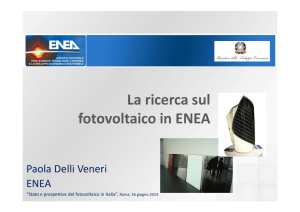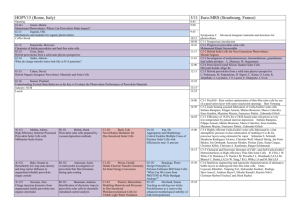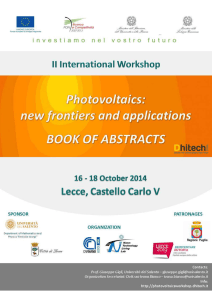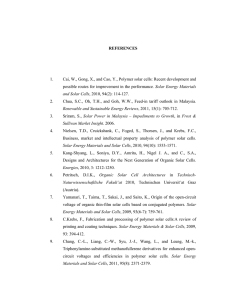a Case Study - prof. Alessandro Mordini
advertisement
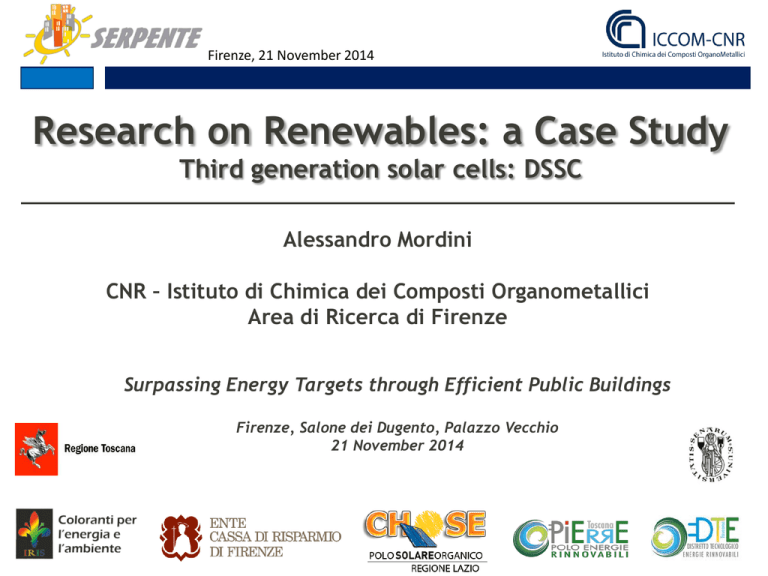
Firenze, 21 November 2014 Research on Renewables: a Case Study Third generation solar cells: DSSC Alessandro Mordini CNR – Istituto di Chimica dei Composti Organometallici Area di Ricerca di Firenze Surpassing Energy Targets through Efficient Public Buildings Firenze, Salone dei Dugento, Palazzo Vecchio 21 November 2014 Firenze, 21 November 2014 Research on renewable energies through a highly multidisciplinary approach «Design and Synthesis of new organic dyes for the production of non-conventional solar cells» from: May 2010 until April 2013 www.fotosensorg.unisi.it «IRIS - Coloranti per l’energia e l’ambiente» from: May 2012 iris.iccom.cnr.it Firenze, 21 November 2014 2030Inc. Energy Outlook (BP) Source: Innovative Clean Energy (2008) • Humanity has constantly increased its energy need and consumption. • Global energy consumption in 2010:12 Btoe = 139.600 TWh (+5.6% compared to 2009). • Most of this energy is produced by fossil fuel. • Result: resources shortage of fossil fuel resources and atmospheric and environmental pollution. • Unless major and urgent changes are made in supply/demand management of energy and/or alternative Energies are made sufficiently available, the maximum supportable worldwide human population level will peak between 2025 and 2050 Europe 2020 Initiative 1) -20% greenhouse gas emissions 2) +20% energy efficiency 3) ≥20% from renewable sources http://ec.europa.eu/europe2020/index_en.htm Firenze, 21 November 2014 SOLAR ENERGY IS FREE AND PRACTICALLY INEXHAUSTIBLE The volume of the spheres represents the amount of energy potentially (although perhaps not practically) available from every renewable source, together with global consumption in year 2010 Source: Perez et al. ,IEA/SHC, A fundamental look at energy reserve in the planet Italy (16%) and Germany (32%) combined accounted for nearly half of global solar PV capacity Source: Renewables 2013 Global Status Report Firenze, 21 November 2014 a) Monocrystalline silicon b) Polycrystalline silicon Market share: ~ 80%* Old generation 1) Silicon-Based Solar Cells Optimized performances Main Classes of Photovoltaic Cells 2) Thin Film Solar Cells Market share: ~ 20%* a) Bulk heterojunction solar cells (OPV) b) Dye-Sensitized Solar Cells (DSSC) *Source: EPIA (2010) New generation 3) Organic and Hybrid Solar Cells Non-optimized performances a) GaAs b) CdTe c) CI(G)S – CuIn(Ga)Se2 d) Amorphous silicon (a-SiH) Firenze, 21 November 2014 Record DSSC Firenze, 21 November 2014 DSSC have been invented in 1991 by the german chemist Michael Grätzel at EPFL - Lausanne (Switzerland). Main features- pros Michael Grätzel • Good cells efficiencies (ηmax > 12%, lab scale). • Performances relatively independent by irradiation conditions. • Raw material easily available and low cost production. • Possible use of different supports (glass, polymeric materials). • Construction of either transparent or opaque cells in different colours. Limitations- cons • Modules efficiency still too low (tipically between 6% and 9%). • Stability and lifetime, despite continuosly increasing, not satisfactory yet (problems: corrosion, leak of material, degradation). • Limited number of practical applications (prototypes, small electronic devices). Firenze, 21 November 2014 Cost of module production Production costs: DSSC: 1.21 $/Wp (Solaronix, 2009) c-Si:1.40-1.75 $/Wp (GTM Research, 2010) Thin Films (CdTe): < 1 $/Wp (First Solar, 2011) Energy Payback Time (EPBT) Growth Rate Forecast LCA analysis: Major out-comes show that DSSCs compare similarly and are sometimes better than inorganic thin film devices, even for a far-from-optimum industrial fabrication procedure. M. L. Parisi, S. Maranghi, R. Basosi Renew. Sust. Energ. Rev. 39 (2014)124–138 Raw materials: Firenze, 21 November 2014 Japanese company Fujikura has performed detailed investigations on the relationship between solar radiation and DSSC modules performances. Light intensity Incident angle Temperature effect Firenze, 21 November 2014 Due to their better performances under diffuse light, DSSC modules of the same nominal power produce more energy compared to p-Si modules (approximately1.6 times higher on the north wall). Firenze, 21 November 2014 Accelerated tests with solar simulator 20.000 h = 2 y 103 d In these conditions the duration of the test is assumed to correspond to a real utilization lenght of 20 years – however, bear in mind this is only a simulation! Firenze, 21 November 2014 Test under real conditions of use Jsc Voc FF η After around 2.5 years module efficiency was still above 80% of the initial value Deterioration factor: 0.02% / day N. Kato et al., Sol. Energy Mater. Sol. Cells 2009, 93, 893. Firenze, 21 November 2014 Some commercial applications backpack with small flexible DSSC panels for recharging batteries of portable electronic devices (e.g. mobile phones, mp3 players etc.) ‘Folio’ Solar Keyboard a new iPad® cover endowed with a DSSC-powered keyboard. Hana Akari, Flower Lamp Firenze, 21 November 2014 Forecasted growth of DSSCs in different market segments Source: IDTechEx report Dye Sensitized Solar Cells 2013-2023: Technologies, Markets, Players Ease transition to: EPFL, Lausanne Building-Adapted PhotoVoltaics Building-Integrated PhotoVoltaics Firenze, 21 November 2014 BIPV: Building Integrated PhotoVoltaics Toyota «Dream House», Aichi CSIRO Energy Centre, Newcastle House of the Future Prototype, OlympicVillage, Sydney Firenze, 21 November 2014 EPFL Conference Center (Solaronix, CH) Firenze, 21 November 2014 Geneva Airport (g2e, CH) Prototypes of Solar Windows (Dyesol, AUS) Firenze, 21 November 2014 Projet BIPV - Gare TGV de Perpignan (ISSOL – Belgium) See-through solar energy panel (Sharp, Jpn) Firenze, 21 November 2014 Renovation of MGM Hotel – Las Vegas DSSCs mounted on Motorized Blinds over the windows, power a DC motor and enable the user to control the solar shading with the use of a remote or wall mounted switch. Firenze, 21 November 2014 Indoor application Electronic Shelf Labels (ESL) Update the prices daily via the RF transmission technology TV remote control Sensors Firenze, 21 November 2014 Glass Electrolyte Solution (I-/I3-) Transparent Conductive Oxide Platinum TiO2 Dye Glass Dye: 1. Improvement of light absorption and electonic transfer properties. 2. Simpler and more efficient synthetic procedures. 3. New dyes for transparent materials and for new colours. TiO2: Studies on the morphology and size of nanopartcles; superficial modifications. Electrolytic solution: Synthesis and application of (metall)organic compounds as an alternative to the usual redox couple iodide/triiodide; studies on the use of non volatile solvents and solid phase electrolytes. Firenze, 21 November 2014 Mechanism 1. Light absorption 2. Photoexcitation 3. Injection 4. Charge collection 5. Electrolyte reduction 6. Regeneration In the DSSCs the functions of photon absorption and charge separation/ transport are made by different components. Firenze, 21 November 2014 Dyes (sensitizer): ideal properties a) Broad and efficient light absorption in the visible and near-infrared region (-conjugation). b) Should have functional groups allowing a good anchoring on TiO2 (COOH). c) Its energy levels should be correctly aligned to ease regeneration and electron injection. d) It should not aggregate on the surface of the semiconductor (alkyl chains). e) It should be thermally, chemically and photochemically stable. f) For application in BIPV must be designed in different colours and transparency. Test cells ready for stress measurements Firenze, 21 November 2014 Computational analysis FEEDBACK Design of new organic photosensitizers Assembly of laboratory cells and efficiency measurements Laboratory synthesis Characterization Firenze, 21 November 2014 Structural design supported by TD-DFT calculations Donor Group donor group -Spacer Acceptor Group -spacer • • • acceptor group TiO2 Tuning of the energy levels and of the HOMO-LUMO gap Influence on color (λmax), intensity of absorption (ε) • Increase in the stability of the dye/semicondutor assembly Influence on electron transfer and device lifetime Firenze, 21 November 2014 Efficiency measurements Compound CDCA best η (%) DF13A − 3.14 DF13B + 3.24 DF13C + 3.02 DF15 + 6.04 Desorption kinetics from TiO2 Cell stability over 1000 h KOH 0.1 M in EtOH Daniele Franchi, Massimo Calamante Tetrahedron (Symposium-in-Print) 2014, 70, 6285 Firenze, 21 November 2014 2nd Generation dyes • 510 < max < 521 nm in all cases. Molar extinction coeffcients > 80000. Clear improvement of the electronic, optical and physico-chemical properties compared to previous gen. TTZ3-5: Chem. Commun. 2014, DOI: 10.1039/C4CC06160H Firenze, 21 November 2014 2nd Generation dyes Consistent with our aims: tests significant toward possible application in BIPV Simple fabrication: NO TiCl4 treatment, NO scattering layer, I−/I3− redox couple Thin TiO2 films: 5.5 μm (transparent) – 6.5 μm (opaque) J-V curves Stability Test 1000h ageing in the dark @ 85°C • Best cell efficiency: = 7.39 - 7.71% for TTZ5 (transparent ad opaque cells, respectively). • Performances superior to reference dyes D5 (organic) and Z907 (Ru-based). Daniele Colonna (C.H.O.S.E, Roma) TTZ3-5: Chem. Commun. 2014, DOI: 10.1039/C4CC06160H Firenze, 21 November 2014 Firenze, 21 November 2014 Research on renewable energies through a highly multidisciplinary approach «Design and Synthesis of new organic dyes for the production of non-conventional solar cells» from: May 2010 until April 2013 www.fotosensorg.unisi.it «IRIS - Coloranti per l’energia e l’ambiente» from: May 2012 iris.iccom.cnr.it Firenze, 21 November 2014 Progetto FAR FAS 2014 Selfie: Sistema di Elementi avanzati multi Layer basato su superFici e materiali Innovativi nanostrutturati per una Edilizia sostenibile ed energeticamente efficiente Pannelli fotovoltaici di terza generazione integrati in architettura Progetto POR FESR 2014-2020 Encolor Design: ENergia rinnovabile da pannelli fotovoltaici COLORati architettonicamente integrati Pannelli fotovoltaici di terza generazione integrati in architettura Firenze, 21 November 2014 Progetto Smart Cities and Communities (MIUR) Smartgate plus: Smart Solution for a Transparent, Efficient, and more Sustainable Administrative Justice Riqualificazione energetica di edifici di pregio sedi di tribunali amministrativi Progetto Ente Cassa di Risparmio di Firenze IRIS: Coloranti per l’energia e l’ambiente Progettazione, preparazione e caratterizzazione di nuovi materiali per celle DSSC Firenze, 21 November 2014 Acknowledgments CNR-ICCOM Università degli Studi di Siena Dr. Gianna Reginato Dr. Lorenzo Zani Dr. Massimo Calamante Dr. Grabriella Barozzino Alessio Dessì Bianca Cecconi Daniele Franchi Damiano Cirri Ottavia Bettucci Giovanna Burgio Rocco De Lorenzo Matteo Bessi Marco Monini Prof. Maurizio Taddei Dr. Fabrizia Fabrizi de’ Biani Prof. Riccardo Basosi Dr. Adalgisa Sinicropi C.H.O.S.E - Università di Roma «Tor Vergata» Prof. Aldo di Carlo Dr. Daniele Colonna «FOTOSENSORG» Project (2010-2013) Funding Dr. Maurizio Peruzzini Università degli Studi di Firenze Prof. Mara Bruzzi Dr. Riccardo Mori Michele Spatola Prof. Roberto Bianchini Dr. Marco Corsi Dr. Marco Bonanni «IRIS» Project (2013-2015) Progetto Premiale «Energia da fonti rinnovabili» 24 Richiamo a serpente Building trasparenti: importanza Firenze, 21 November 2014 Firenze, 21 November 2014 Photovoltaic Cell: a device capable of converting sunlight into electricity Main classes of photovoltaic cells: Silicon-Based Solar Cells Thin Film Solar Cells Organic and Hybrid Solar Cells •Monocrystalline silicon •GaAs •Polycrystalline silicon •CdTe •CI(G)S – CuIn(Ga)Se2 •Amorphous silicon •Organic solar cells (OSC) •Dye-Sensitized Solar Cells (DSSC) •Perovskite Solar Cells Old generation New generation Optimized performances Pmax Non-optimized performances Jsc· Voc· ff Mettere performance Pmax: maximum power produced by the cell s Efficiency: η = Pin = Pin Pin: power of incident solar radiation It should always be coupled with a good stability! Current/Voltage (J/V) curve Firenze, 21 November 2014 Dyes (sensitizer): design, synthesis and characterization A multidisciplinary approach Progetti in corso, citare horizon 2020 e serpente, regione, comune… DSSC: Progetti in corso Progetto Smart Cities and Communities (MIUR) Smartgate: Giustizia Amministrativa Riqualificazione energetica di edifici di pregio sedi di tribunali amministrativi Palazzo spada, Roma Sede dell Consiglio di Stato Progetto Nazionale in corso di valutazione 1° Forum Internazionale, Sviluppo Ambiente Salute, Arezzo, 22.11.2012 Firenze, 21 November 2014 Main Classes of Photovoltaic Cells 1) Silicon-Based Solar Cells a) Monocrystalline silicon b) Polycrystalline silicon Market share: ~ 80%* 2) Thin Film Solar Cells a) GaAs b) CdTe c) CI(G)S – CuIn(Ga)Se2 d) Amorphous silicon (a-SiH) Market share: ~ 20%* 3) Organic and Hybrid Solar Cells a) Bulk heterojunction solar cells (OPV) b) Dye-Sensitized Solar Cells (DSSC) *Source: EPIA (2010) Firenze, 21 November 2014 Dyes (sensitizer): ideal properties a) Broad and efficient light absorption in the visible and near-infrared region (-conjugation). b) Should have functional groups allowing a good anchoring on TiO2 (COOH). c) Its energy levels should be correctly aligned to ease regeneration and electron injection. d) It should not aggregate on the surface of the semiconductor (alkyl chains). e) It should be thermally, chemically and photochemically stable. f) For application in BIPV must be designed in different colours and transparency. The development of this technology is well suited for small and medium size companies dealing with all the manufacturing indicated below CELLS PRODUCTION Glass manufacturer Supports (plastic, metal) Electrodeposition Semiconductor Cell printing APPLICATION Housing components Furniture Accessories Lamps Doors, windows…. INNOVATION IN DESIGN Opportunity for coupling made in Italy and technology DSSC: Materials and Structure Glass Electrolyte Solution (I-/I3-) Transparent Conductive Oxide Platinum TiO2 Dye Glass 1. 2. 3. 4. 5. 6. 7. Components Glass substrate TCO layer (transparent conductive oxide) Nanocrystalline semiconductor (TiO2) Dye (adsorbed on the semiconductor) Electrolyte solution Counter electrode (usually Pt) Glass substrate http://www.solarprint.ie/images/dssc.jpg Alessandro Mordini– EUSEW, Bruxelles, 22.06.2012 7/13 DSSC: Mechanism Mechanism 1. Light absorption 2. Photoexcitation 3. Injection 4. Charge collection 5. Electrolyte reduction 6. Regeneration Nelle DSSC il processo di assorbimento della luce e quello di separazione/trasporto dei portatori di carica sono svolti da due componenti distinti. Alessandro Mordini– EUSEW, Bruxelles, 22.06.2012 7/17 Solar radiation spectrum Solar radiation should be adsorbed in the visibile and near infrared. Alessandro Mordini– EUSEW, Bruxelles, 22.06.2012 2/17
